Science / Functional Breathing Technique / Holding Your Breath: Benefits and Science
Holding Your Breath: Benefits and Science
Breath Holding Benefits and the Oxygen Advantage® — The Surprising Role of Breath Holding in Athletic Performance
If you took a moderately paced run alongside an elite athlete, you would expect his or her breathing to be light, rhythmic, and easy. You certainly wouldn’t imagine her to be huffing and puffing like a steam train. But it may surprise you to know that this easy breathing has more to do with carbon dioxide than cardiovascular fitness. And that you can achieve similarly effortless breathing during exercise, just by holding your breath.

What Is Hypoxia?
Hypoxia is a medical term that refers to a deficiency in the amount of oxygen reaching the tissues. There are many causes of hypoxia, but the most common is a lack of oxygen. When the body is deprived of oxygen, it can cause serious health problems.
Hypoxia can affect any organ in the body, but it is most commonly seen in the brain, heart, and lungs. Hypoxia can cause seizures, coma, and even death.
What Is Hypercapnia?
Hypercapnia is a condition that results from too much carbon dioxide (CO2) in the blood. This can happen for several reasons, including:
- Breathing disorders such as sleep apnea
- Severe asthma attacks
- Heart problems causing reduced blood flow to the lungs
- Poor liver function
- Kidney failure
When hypercapnia occurs, the body tries to compensate by increasing the breathing rate (called tachypnea) and the heart rate (called tachycardia). If left untreated, hypercapnia can lead to several serious health problems, including coma and death.
How Do Hypoxia and Hypercapnia Affect Athletes?
Hypoxia is a lack of oxygen in the body, which can have major consequences for athletes. When the body is deprived of oxygen, it can’t produce energy efficiently, leading to fatigue and, ultimately, performance decline.
Hypercapnia is an excess of carbon dioxide in the blood, which has serious consequences for athletes. When there is too much carbon dioxide the body, which is toxic, the body can’t expel it quickly enough, leading to many problems, including respiratory failure.
What Are the Benefits of Hypoxia and Hypercapnia Training for Athletes?
Both hypoxia and hypercapnia training can improve endurance, increase the amount of oxygen your body can use, and help protect muscles from damage. In addition, hypercapnia training can improve your strength, power, and sprint performance.
Both forms of training have been shown to be safe and effective in several sports. So if you’re looking for an edge over the competition, consider adding hypoxia or hypercapnia training to your routine.
What the scientists say about hypoxia and hypercapnia
A study by researchers at Nagoya University in Japan found that athletes have a significantly greater tolerance to carbon dioxide at rest than untrained individuals. The study found that, for the same amount of exercise, athletes experienced 50 to 60% less breathlessness than the untrained people did [1].

Scientists have also shown that one of the main differences between endurance athletes and non-athletes is the response to low pressures of oxygen (hypoxia) and higher levels of carbon dioxide (hypercapnia) in the blood [2,3]. In a paper published in Medicine and Science in Sports, the authors found that breathing in non-athletes is much heavier and faster in response to changes in oxygen and carbon dioxide than it is in endurance athletes at equal workloads. The authors observe that this lighter breathing in the athlete group may explain the link between “low ventilatory chemosensitivity and outstanding endurance athletic performance.” [3] In simple terms, low sensitivity to CO2 is instrumental in the impressive endurance of these athletes.
In another study, the exercise physiologist, Xavier Woorons, notes that trained athletes breathe less than untrained men. This is probably due to a weaker hypercapnic ventilatory response (improved tolerance to carbon dioxide) in trained athletes [4]. In other words, endurance athletes can tolerate a greater concentration of carbon dioxide and lower concentration of oxygen in the blood during exercise. The changes in blood gases don’t have such a strong effect on their breathing. Reduced breathing frequency has itself been shown to reduce the ventilatory response to carbon dioxide [5,6,7].
To attain outstanding performance during sports, it is essential that your breathing does not react too strongly to increased concentrations of carbon dioxide and decreased concentrations of oxygen. Intense physical exercise requires greater oxygen consumption. And it causes carbon dioxide production to increase too.
It is common for even elite athletes to have dysfunctional, inefficient breathing. Some start with a relatively low BOLT score.
Over time, intense physical training will help to condition the body to better tolerate changes in blood gas levels.
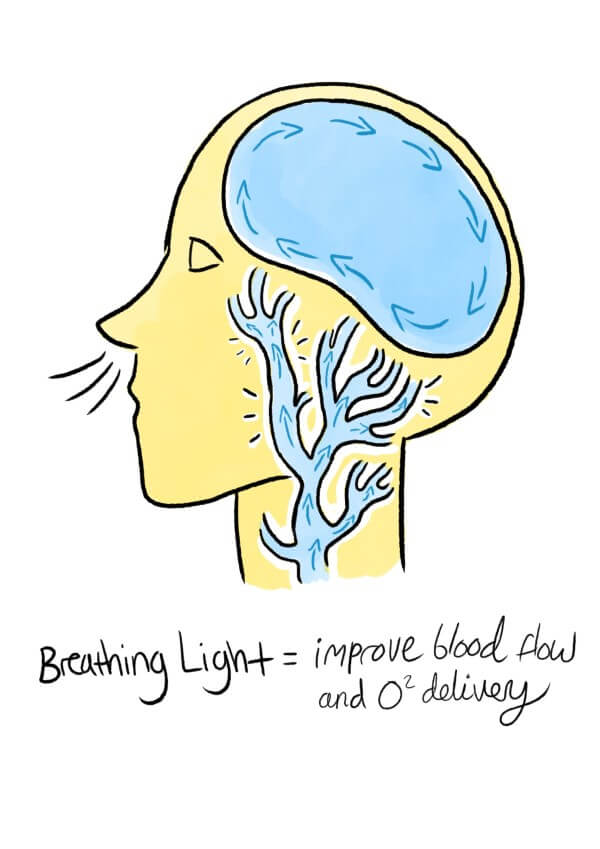
But a more effective method can be found in the Oxygen Advantage® program. By applying breathing exercises to address dysfunctional breathing patterns, and by practicing breath holding to simulate high altitude training, you can cause your body to make adaptations that allow you to cope better with low oxygen and higher carbon dioxide.
What is high altitude training and what does it have to do with breath holding?
High altitude training has long been a secret weapon for endurance athletes. If you can push yourself to train hard where atmospheric oxygen is low, you’re at an advantage when you return to sea level.
But you can get the same results without trekking up a mountain.

The Oxygen Advantage® method uses hypoxic/hypercapnic breath training, which we call simulation of high-altitude training. This type of training can involve the use of a training (elevation) mask.
Despite what many mask manufacturers will tell you, the mask itself does not simulate high altitude. Instead, it creates resistance to breathing, adding a load to the breathing muscles. As you continue to breathe through your nose, the diaphragm becomes stronger.
At the same time, carbon dioxide builds up inside the mask. Over time, this increases tolerance to hypercapnia and reduces sensitivity to CO2.
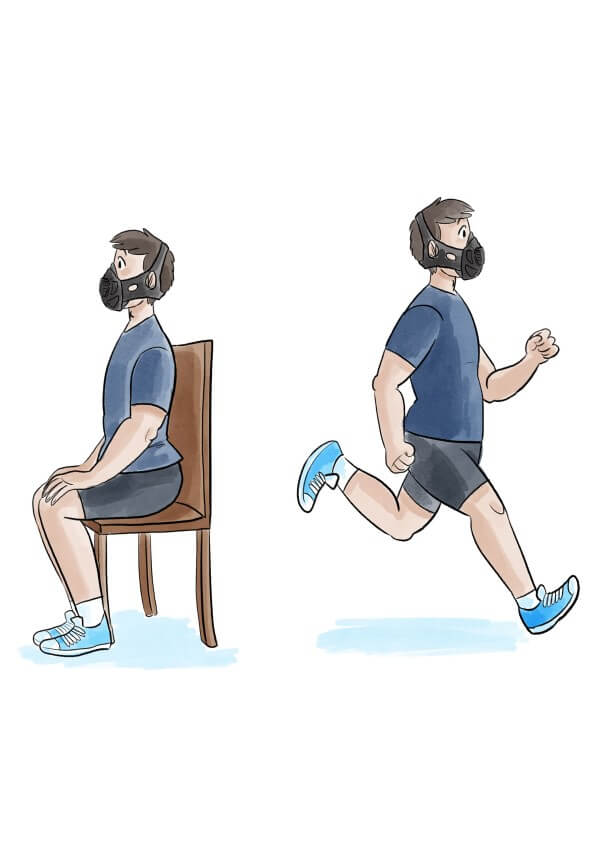
The secret ingredient — transport of carbon dioxide in the blood
- Hypoxia = low concentration of oxygen in the blood (below 90%).
- Hypercapnia = high levels of carbon dioxide in the blood.
- Normal oxygen level = between 95 and 100%.
- Hypoxia and hypercapnia tolerance = the secret tool that gets outstanding athletic results.
Hypoxia is achieved with strong breath holds. The normal concentration of oxygen in blood is 95 to 100%, meaning that, under normal circumstances, your blood is fully saturated with oxygen. But when you practice strong breath holding during physical movement, oxygen can drop to well below 90%.
When the breath is held, carbon dioxide can’t leave the body via the lungs. Instead, it builds up in the blood (hypercapnia). Carbon dioxide has a special relationship with oxygen. It causes the red blood cells to offload blood oxygen to the body. Carbon dioxide also works to open the blood vessels, improving circulation. As carbon dioxide increases, blood oxygenation drops as the bond between the hemoglobin in red blood cells and oxygen weakens. At the same time, oxygenation of the body and brain increases as more oxygen is released from the blood to the tissues, muscles, and organs.
Controlled hypoxia and hypercapnia are excellent for recovery and endurance. Scientists have found hypoxia can speed up muscle repair after injury [8] and increase production of muscle-building stem cells [9].
What are the benefits of breath holding for performance?
Holding the breath until you feel a strong air hunger gives the diaphragm a workout and exposes the body to higher levels of carbon dioxide. It improves tolerance to hypoxia and hypercapnia. You won’t get so breathless, your breathing will be slower, and your performance will improve.
Benefits of hypoxic and hypercapnic training include:
- A stronger immune system.
- Faster healing due to detoxification of metabolic waste.
- Treatment for chronic fatigue and brain fog.
- Increased red blood cell count.
- Improved endurance performance and muscle recovery.
- Increased oxygenated blood flow to the brain and other organs.
- Slowing cognitive decline for patients with Alzheimer’s and other brain disorders.
- Speedy recovery after respiratory infections.
- Increase in formation of blood vessels.
What Are the Risks of Hypoxia and Hypercapnia Training for Athletes?
It is important to be aware of the risks associated with hypoxia and hypercapnia training before you decide to participate in such a program.
Some of the risks include:
- Damage to the lungs
- Seizures
- Strokes
- Heart attacks
- Blackouts
- Death
How Can Athletes Safely Train with Hypoxia and Hypercapnia?
Athletes looking to improve their performance by training in hypoxia and hypercapnia can do so safely by following simple precautions. Here are a few tips to keep in mind:
- Make sure you are medically cleared to train in hypoxia and hypercapnia with your doctor.
- Always start slow when training in hypoxia and hypercapnia, and gradually increase your exposure time as you get used to the conditions.
- Drink plenty of fluids to stay hydrated, and avoid alcohol and caffeine as they can dehydrate you.
- Wear appropriate clothing and sunscreen when training outdoors in high-altitude or hot environments.
- Take regular breaks during your training session, and listen to your body to ensure you’re not pushing yourself too hard.
- Seek medical attention if you experience any adverse effects from training in hypoxia or hypercapnia.
AN ALTERNATIVE TO DOPING FOR IMPROVED SPORTS PERFORMANCE
Blood doping in sport is not going away. The number of detections, high profile reports and investigations suggests a self-fulfilling prophecy. One in which clean athletes succumb to the pressure of doping so they can compete — ironically — on a level playing field. But is it worth it? As we at the Oxygen Advantage® know all too well, there is a better way.
If the performance gains were small, few athletes would risk incurring the suspensions and shame that follow a failed drugs test. However, the prevalence of doping in sport suggests that for many athletes, it is a risk worth taking.
To win the war on doping, anti-doping agencies and sporting organizations must demonstrate that clean athletes can compete. And that they have a good chance of winning against the dopers.
Of course, athletes would prefer not to even consider taking performance enhancing drugs. After all, their lifestyles are far healthier than the general population. They drink less alcohol, eat well, abstain from smoking, and stay physically fitter than their non-athletic counterparts.
Doping seems to go against everything they practice. And it comes with significant health risks. So why do some athletes risk it all by doping or taking illegal substances such as EPO? Why do they go to extremes, and put themselves at risk of blood clots or stroke by taking EPO?
The fact is, doping improves oxygen carrying capacity and increases the delivery of oxygen to working muscles to increase VO2 max, and thereby performance. But it serves to improve only one of the many parameters responsible for winning. Running performance, for instance, is based on many physiological parameters, including psychological preparedness and the ability to withstand fatigue. Or, as the great Finnish runner Paavo Nurmi said: “Mind is everything. Muscles; pieces of rubber.”
While mind and body are interconnected, it is ultimately the mind that rules the body and determines its limits. Races are won and lost not by muscle fatigue and soreness, but by the ability of the brain to cope with effort.

The relationship between the mind and body and exercise performance is at the heart of the “central governor” theory put forward by South African physiologist, Dr. Tim Noakes. In explaining the limitations of human performance, Noakes writes that a “governor” located in the brain sets the limit on exercise intensity, to protect the heart from overworking.
His theory is based on the premise that a “governor” monitors the oxygenation of the heart and other organs, including the brain and diaphragm. When oxygen levels decrease below the threshold determined by the brain as “too low,” messages are sent from the brain to restrain working muscles. Fatigue is experienced to slow down and preserve the athlete. In other words, it is the brain that sets the limitations of the body.
If the “governor” in the brain can be trained to cope with increased demands from the body, athletes become able to push themselves harder, further, and faster, without the need to dope. A major part of this is psychological. Athletes who have the confidence to know how far they can push themselves have the greatest chance of winning.
OA offers athletes an alternative to blood doping. The simple, science-backed breathing exercises deliver improved airway functioning, and address dysfunctional breathing patterns in athletes. The method also features breath hold exercises to simulate training at high altitude.
The breath holding component of OA is interesting. It is a departure from breath hold exercises that have been used by athletes since the 1960s. Instead of breath holding following an inhalation, the technique involves breath holding following a normal exhalation. This causes a significant decrease to blood oxygen saturation and an increase in carbon dioxide, while simultaneously generating intense feelings of breathlessness. In other words, the exercises add an extra load onto the athlete, which would not otherwise be experienced during normal training.
This teaches the brain to adapt to greater demands, to tolerate lower oxygen levels, higher carbon dioxide and higher breathlessness — all of which ultimately delays fatigue and improves performance. Numerous research studies have shown that breath holding following an exhalation improves many of the physiological parameters involved in running performance. What’s more, these maximal breath holds cause the body to naturally produce more EPO — negating the need for blood doping.
Doping risks not only the health of the athlete, but the very future of their sport. Oxygen Advantage® offers a natural – and legal – alternative.
If you are interested in trying the OA method for yourself, why not try our online course, download the free OA Breathing App or find an Oxygen Advantage® instructor near you.
Facts and Tips to Hold Your Breath Longer
You can read more about the performance enhancing benefits of breath holding in the high-altitude science pages. But before you head over there, here are the answers to some common questions about breath holding, and how to practice the breath holding exercises safely…

How long can a human hold their breath?
The average person can hold their breath for around 30 to 90 seconds, though most of us can hold a little longer if we practice deliberate hyperventilation first.
As of March 2021, a 56-year-old free diver from Croatia holds the world record for the longest breath hold. Apnea divers are known for their ability to perform long breath holds, but Budimir Šobat clocked a remarkable 24 minutes 37.36 seconds after inhalation.
Previously the world record for holding the breath was held by Stig Severinsen. In 2012, Severinsen held his breath for 22 minutes. Two years earlier, he had achieved another record-breaking breath-hold after swimming 72 meters under ice wearing only swimming trunks and goggles. This was 14.5 meters further than Wim Hof’s record of March 2000. In 2019, the Turkish athlete, Bilge Cingigiray, walked 86 meters underwater in one minute using a single breath.
How long should you be able to hold your breath?
Breath holding in the Oxygen Advantage® is not meant as a competitive sport or a test of willpower. While some people can learn to hold their breath after inhalation for a very long time, breath holding after exhalation gives a more accurate measure of lung function, sensitivity to carbon dioxide and psychological factors like fear of suffocation. This is why the BOLT score is measured after an exhalation. When we use strong breath holds to simulate training at high altitude, we gauge the length of the breath hold by the strength of our air hunger.
If your BOLT score is low when you begin, it is important not to hold your breath for longer than half the BOLT score. With a BOLT score of 9, you might practice many small breath holds of 3 or 4 seconds. But you wouldn’t practice strong breath holding just yet. It is not advisable to practice strong breath holds until your BOLT score is 25 seconds or more. This protects your body from excessive stress that can slow down progress, exacerbate symptoms and contribute to illness.
How to hold your breath longer?
Swimming is known to help breath holding capacity. Research from 2021 concluded that young, trained swimmers had a reduced hypoxic ventilatory response and greater maximal voluntary apnea (breath hold) duration (after inhalation) [10]. But really the best way to increase breath hold time is to develop better tolerance to CO2. You can do this by practicing the Oxygen Advantage® breathing exercises.
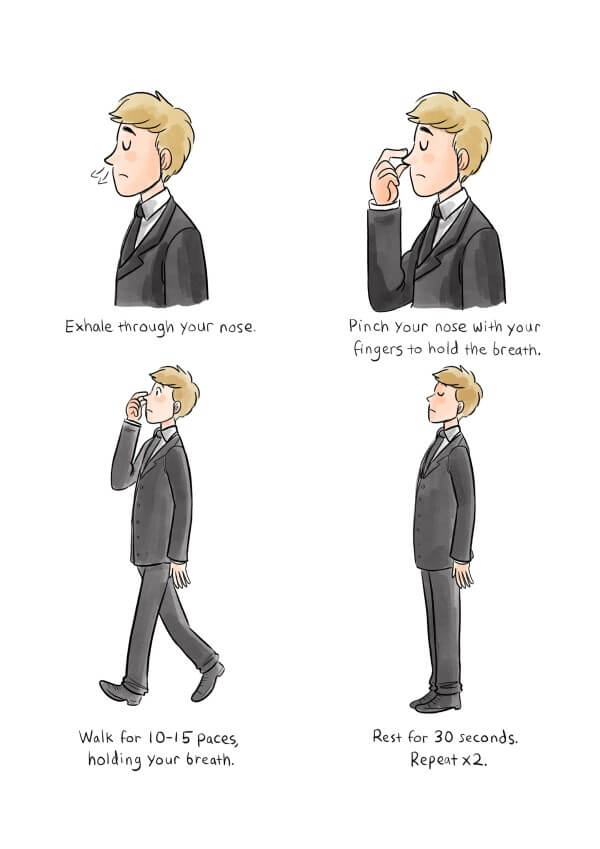
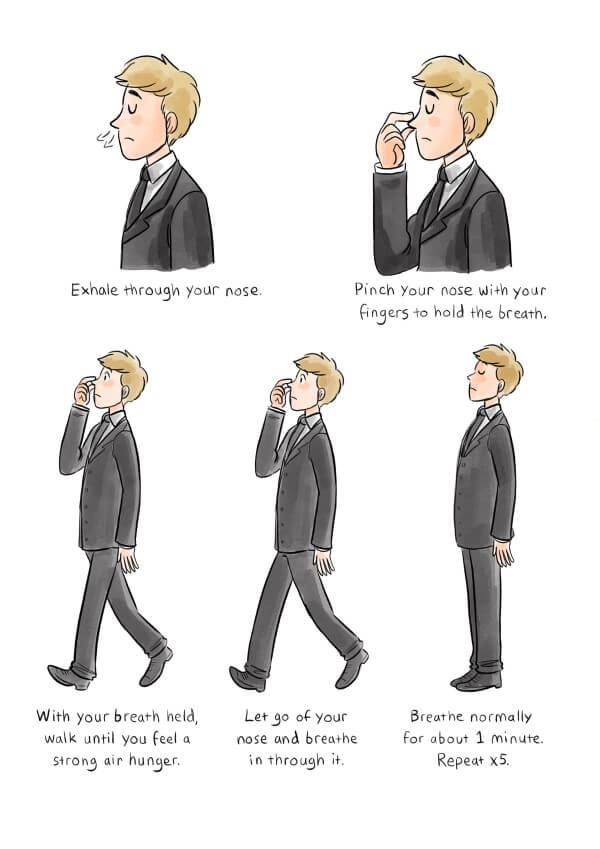
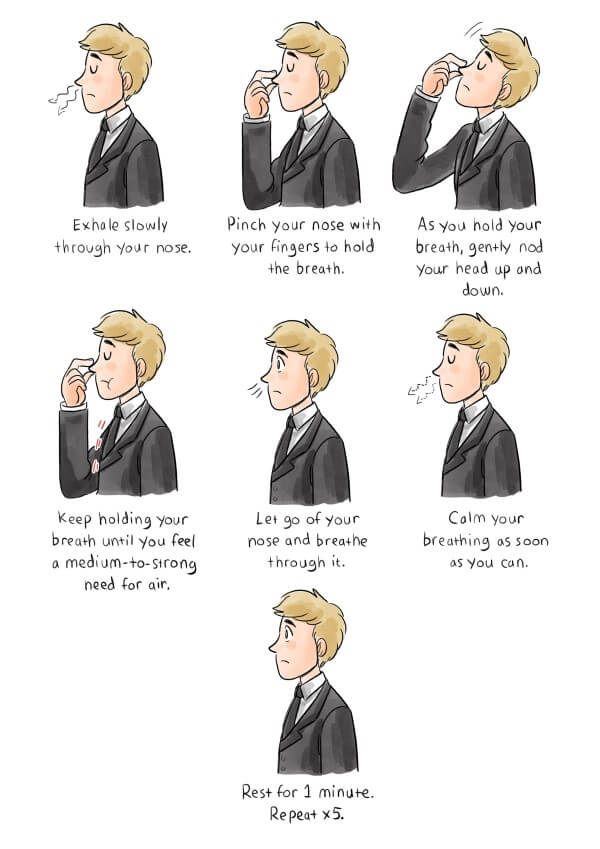
What happens if you hold your breath too long?
When you practice exercises involving light/easy breath holds but extend your breath hold beyond half your BOLT score, you may experience uneven breathing when you take your next inhalation. The aim is always to resume breathing with a normal breath in through your nose, not a big gasp of air through your open mouth. You may also experience a dry mouth and cold hands, or feelings of panic and suffocation. All these indicate you have pushed your body into a stress response.
If you push your body too far during a breath hold, you may feel an urgent need to pee when you resume breathing. You will feel your diaphragm begin to contract as your brain sends the signal to breathe in. Don’t push yourself to hold beyond what feels bearable.
Some breathing methods use deliberate hyperventilation before breath holding to prolong the breath hold. They work by getting rid of carbon dioxide, dampening the brain’s ventilatory response. It has been known for people to pass out or experience side effects from these types of breath holds, and there have been some cases of shallow water drowning that occurred because the practitioner blacked out while breath holding. This is why we strongly advise against breath holding in or near water.
Holding the breath after a normal exhalation is safe if you are generally healthy. It is not so easy to use willpower to push too far, and your body will let you know when it’s time to breathe in.
What are some breath holding benefits?
The breath holding exercises to simulate altitude have many benefits for sports performance and health. You can use breath holds to:
- Delay the onset of fatigue and lactic acid, so you can exercise for longer and recover faster
- Improve repeated sprint ability for team sports such as rugby and football/soccer
- Improve respiratory muscle strength — this has many benefits including greater breathing efficiency, increased endurance, and even better sexual function and pelvic floor health
- Improve aerobic capacity
- Increase production of EPO (erythropoietin) safely and legally
- Improve running economy and running time
- Improve swimming performance
- Reduce oxidative stress, effectively slowing your aging process
Is it safe to practice breath holding exercises?
Strong breath holding exercises are only suitable if you are in good health. If you have any concerns, consult your medical doctor before practicing the exercises.
You should never practice breath holds if you are in or near water, or if you are pregnant. The impact of breath holding on the unborn baby is not known.
You should not practice strong breath holds if you have:
- High blood pressure
- Epilepsy
- Diabetes
- Schizophrenia
- Uncontrolled hyperthyroidism
- Chest pains or heart problems
- Sickle cell anemia
- Cancer
- Arterial aneurysm
- Kidney disease
- Panic disorder and/or anxiety
- Sleep apnea
- Cardiovascular issues
Does holding your breath burn calories?
When you lose weight, fat breaks down into carbon dioxide, hydrogen, and oxygen. The hydrogen (H) and oxygen (O2) leave your body as water (H2O) while you get rid of CO2 via the lungs. In fact, 84% of every fat molecule leaves the body in exhaled air.
This explains why exercise helps us to lose weight — because the more we move, the more we breathe.
But where do breathing exercises to reduce breathing come in? When breathing is more efficient, you will quite simply enjoy exercise more. Your metabolism will work better. And you will be able to walk, run or cycle for longer before you gas out with jelly legs. The more you move, the more calories you will burn.
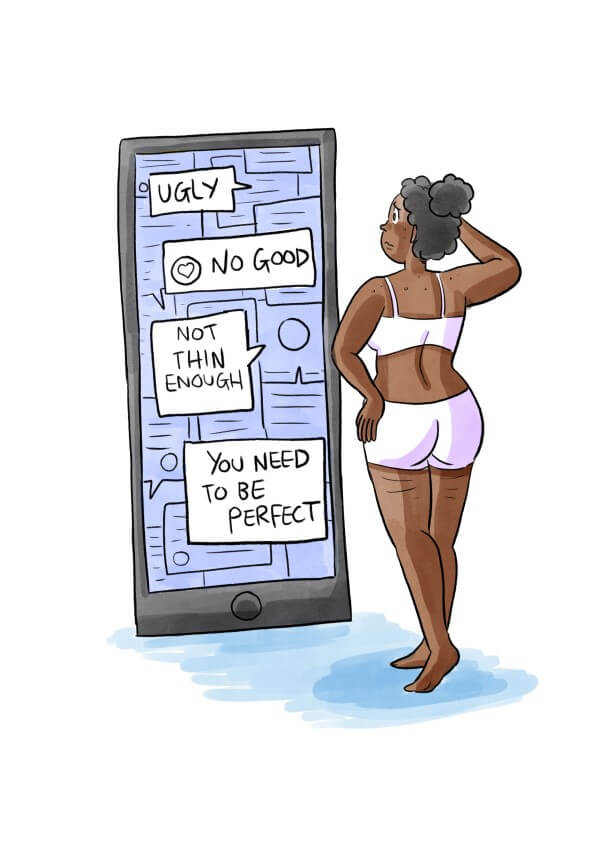
When oxygenation is optimal, your body can access the energy from the food you eat. And as you spend more time focusing on a breathing practice, you will notice you’re motivated to change other habits for healthier alternatives too. The strong breath holding exercises in the Oxygen Advantage® method will burn some calories. But you’ll burn more from the increased aerobic and anaerobic fitness that come as a result of practicing them.
References:
- Miyamura M, Yamashina T, Honda Y, Ventilatory responses to CO2 rebreathing at rest and during exercise in untrained subjects and athletes. The Japanese Journal of Physiology 1976; 26: 245-54
- Scoggin et al. stated that, “one difference between endurance athletes and non-athletes is decreased ventilatory responsiveness to hypoxia (low oxygen) and hypercapnia (higher carbon dioxide).” See: Scoggin CH, Doekel RD, Kryger MH, Zwillich CW, Weil JV. Familial aspects of decreased hypoxic drive in endurance athletes. Journal Applied Physiology 1978;(Mar;44(3)):464-8
- Martin BJ, Sparks KE, Zwillich CW, Weil JV. Low exercise ventilation in endurance athletes. Med Sci Sports.1979;(Summer;11(2):):181-5
- Woorons1, P. Mollard1, A. Pichon1, C. Lamberto1,2, A. Duvallet1,2, J.-P. Richalet. Moderate exercise in hypoxia induces a greater arterial desaturation in trained than untrained men. Scand J Med Sci Sports 2007: 17: 431–436
- Jakovljevic DG, McConnell AK. Influence of different breathing frequencies on the severity of inspiratory muscle fatigue induced by high-intensity front crawl swimming. J Strength Cond Res, 2009; 23, 1169-1174.
- Kapus J, Kapus V, Štrumbelj B. Ušaj A.Can high intensity workloads be simulated at moderate intensities by reduced breathing frequency? Biol Sport, 2010a; 27, 163-168.
- Kapus J, Ušaj A, Lomax M. Adaptation of endurance training with a reduced breathing frequency. J Sports Sci Med, 2013;12 (4), 744-752.
- Ferreira, Inês Raquel Antunes. “Effect of intermittent hypobaric hypoxia on induced muscle injury repair in laboratory rats.” Master’s thesis, 2012.
- Jash, Sukanta, and Samit Adhya. “Effects of transient hypoxia versus prolonged hypoxia on satellite cell proliferation and differentiation in vivo.” Stem cells international 2015 (2015).
- Arce-Álvarez, Alexis, et al. “Hypoxic Respiratory Chemoreflex Control in Young Trained Swimmers.” Frontiers in physiology 12 (2021): 215.